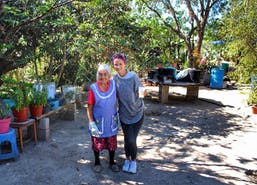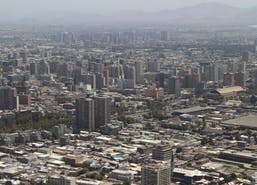New Friends in Mexico City
Porfirio Diaz’s Francophilia still beams through in Mexico City. The capital is a mix between Paris, with incredible architecture and indifference leading to social progression, and New York, where the size and pockets of trendy and new pop up just as fast as they fade. I’d say my experience mirrored the atmosphere of CDMX too. I made friends, traditional and progressive, who were overwhelmingly kind by playing tour guide. Though they agreed on very little about their home, neither missed a chance to mention the insane population and horrendous, crawling traffic.
Enrique and Luis tended to be on the safer side, “I would put the population at 26 million, being that Mexico City itself is 8 million. But there isn’t a difference between here,” Ricky, as he liked to be called, gestured behind him toward the downtown area, “to over there” casually, flicking his hand in front of him to signal the outer part of CDMX.


It was about 2pm, and we were sputtering along in Ricky’s creaky, yet reliable 2000 Toyota Yaris to a restaurant in Polanco. I’d been working in the hotel most of the day, so I welcomed the break of a “very traditional Mexican meal,” as Ricky assured me. His lunch spot of choice was Villa Maria. With its brightly colored stucco facade, and huge scrolled letters to the left of the doorway, it didn’t seem terribly different from Mexican restaurants I’d been to in Texas. Yet that was naive. One of the huge differences is that lunch in Mexico is meant to be taken at a leisurely pace. The quick and cheap Tex-Mex joints to which I’d grown accustom would not be given much thought here.
The conversation is accompanied by the food, and believe me there’s a lot of that and drinks, too. Only a few moments after sitting down, I had a margarita with chips and guacamole to be shared. We started small talk, talking about work and family, while nibbling on sopecitos (sope is a mix between masa and a tortilla, it’s thick and quite grainy) with chicken and chorizo. Then, as our familiarity with each other grew, a tequila shot was ordered, and out came the main dishes. To be quite honest, a margarita and tequila before substantial food had me a little forgetful, so I didn’t take note of everything we ate. What I do know is that there were some spicy dishes with octopus, beef, and pork, all of which came with fresh tortillas, salsas and guacamole for toppings. As intimidating as the dark-red spiced plates looked, I came to find out that the Mexicans with which I dined, interchanged their use of spicy and flavorful. Nothing had me panicking to chug water.
We ended with more drinks offered, a hesitant nod to some chocolate cheesecake, and an interesting take on Trump from those across the border. First, Ricky was almost shy in asking me if Trump was an open supporter of the Ku Klux Klan. Apparently, there are convincing articles labeling Trump as part of the KKK. I put the rumors to rest, and then asked his true thoughts about our political state. Ricky’s demographic (above 55 years of age) think Trump is arrogant, and has ruined the delicate political relationship between Mexico and the U.S. Now they are more fearful of how Trump’s decisions will impact relationships globally – not just with Mexico.
When the end of the evening hit, I was again in Ricky’s faithful Yaris being taxied back to my hotel. We were making small talk by that point. I was tired, and ready to go to bed. Yet, he left me with something that I found true in all Mexicans I met. As a culture, they hold happiness above everything. He told me countless stories about his daughters, their friends, and co-workers, all of which periodically ask each other if they’re happy. As grumpy and exhausted as I felt, I perked up with his parting words. He reminded me of why I chose to travel. He’s right, what’s the point if you’re not happy?

“The population is closer to 30 million, I bet,” Mau assured me that 26 million was far too little for Mexico City. He surmised that it would take at least 5 hours to get across the city in traffic, not the measly 3 or 4 that Ricky and Luis had told me. This was only moments after I’d walked into a Zara right off Reforma, did he share his update. I met Mau holding pieces to an almost-complete suit. We hugged, kissed cheeks, and he introduced me to his on-the-phone friend, Alvi. He greeted me with the same hugging and cheek kissing as Mau, but continued with his phone call until we left the store.
The 3 of us decided to take the big, red Turibuses that I typically avoid in large cities. However, they assured me it would take us where we needed to go. Not only that, even though they lived in the area, neither came to the city often. So, I suspected they were slightly excited to play tourist with me. We meandered through downtown at a surprisingly fast rate. Having a bird’s eye view, I noticed most walls adorned with some graffiti. There are buildings covered with commissioned artworks, while others seemed like the handiwork of someone less skilled. But my eye kept picking up on these crude 43s spray-painted in black or white on buildings and most statues along Reforma.
I asked Mau and Alvi its significance, but before I got my explanation, Alvi asked what was Mau’s conspiracy theory. As Mau explains it, there was a group of not good kids, 43 of them, who disappeared from a school. There had been theories that they were taken by the cartels for meddling. However, the real outrage was the mishandled investigation by the Mexican Government. “43” has turned into a national symbol for truth. Many Mexicans latch onto two facts – in the loose sense of the word – 1) the Iguala students were taken alive, and 2) the families were lied to by the Mexican Government. Whatever the case may be, Mau and Alvi agreed that 43 is embedding itself in the culture, and will one day have a statue to be spray-painted with the next outward display of social unrest. (1)(2)(3)


Our oddly lighthearted, but in depth conversations continued throughout the day. Mau, a lawyer in a past life, and Alvi, a former molecule from Spekadekoo (one of his many stories), spoke about their shared downhill mountain biking business. Mau had quit his life in law to seek projects with more passion, not to mention he was unhappy with the hard hours. The jury is out about the work-life balance on Spekadekoo, but I can only imagine it was awful considering he came to a new planet entirely. Yet through both their talk, they’ve built this business on clients who are affluent Mexicans. It’s interesting that they keep afloat from those who live the very lifestyle they denounced.
To end the night, Mau took us to a restaurant with a speakeasy jazz bar, Parker & Lenox. One that he takes all his first dates to – lucky me. There I got to see what truly balanced Mau and Alvi. The former, is practical. He dates because he wants to, does business with the upper class because it funds his passion, and only worries when he needs to worry. He’s happy, and doesn’t question it. Alvi is a little different. He wants to find someone to love, sort of fell into mountain biking, and constantly worries. I think he’s unhappy, but is more worried about finding it than most.
Our conversation fell away. We’d exhausted ourselves talking about the existence of god, Trump (of course), drinking, women, and jazz. I left Mau and Alvi with a similar feeling that I had when leaving Ricky. All those I met were hard working. They were exceptionally kind. Yet above everything else, they held personal happiness in the highest regard.





